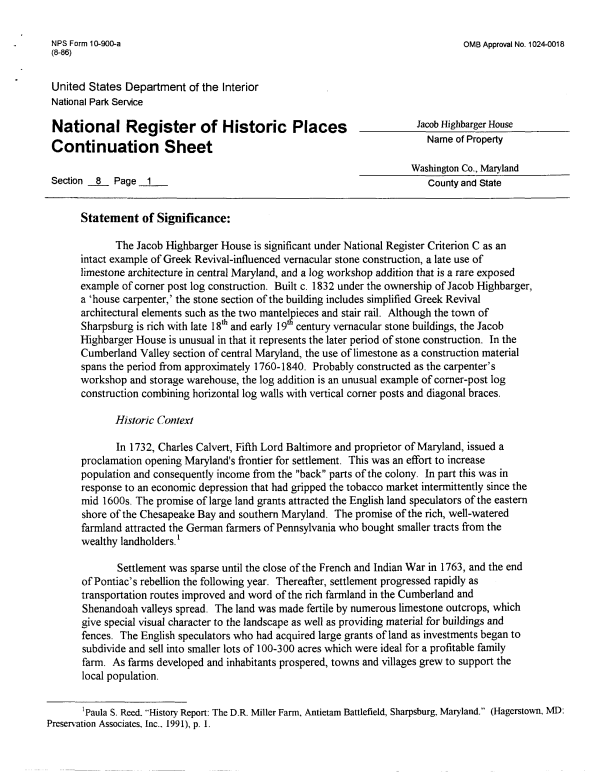 |
||||
|
DEPARTMENT OF HOUSING AND COMMUNITY DEVELOPMENT, MARYLAND HISTORICAL TRUST (Historic Sites Survey) var.d. MSA SE16-10 Image No: se16-10-0414 Enlarge and print image (68K) |
 |
||||
|
DEPARTMENT OF HOUSING AND COMMUNITY DEVELOPMENT, MARYLAND HISTORICAL TRUST (Historic Sites Survey) var.d. MSA SE16-10 Image No: se16-10-0414 Enlarge and print image (68K) |
| NFS Form 10-900-a OMB Approval No. 1024-0018 (8-86) United States Department of the Interior National Park Service National Register of Historic Places ___jag* Highbarger HOU^___ Continuation Sheet Name of Proper,, Washington Co., Maryland Section 8 Page _J__ County and State Statement of Significance: The Jacob Highbarger House is significant under National Register Criterion C as an intact example of Greek Revival-influenced vernacular stone construction, a late use of limestone architecture in central Maryland, and a log workshop addition that is a rare exposed example of corner post log construction. Built c. 1832 under the ownership of Jacob Highbarger, a 'house carpenter,' the stone section of the building includes simplified Greek Revival architectural elements such as the two mantelpieces and stair rail. Although the town of Sharpsburg is rich with late 18th and early 19 century vernacular stone buildings, the Jacob Highbarger House is unusual in that it represents the later period of stone construction. In the Cumberland Valley section of central Maryland, the use of limestone as a construction material spans the period from approximately 1760-1840. Probably constructed as the carpenter's workshop and storage warehouse, the log addition is an unusual example of corner-post log construction combining horizontal log walls with vertical corner posts and diagonal braces. Historic Context In 1732, Charles Calvert, Fifth Lord Baltimore and proprietor of Maryland, issued a proclamation opening Maryland's frontier for settlement. This was an effort to increase population and consequently income from the "back" parts of the colony. In part this was in response to an economic depression that had gripped the tobacco market intermittently since the mid 1600s. The promise of large land grants attracted the English land speculators of the eastern shore of the Chesapeake Bay and southern Maryland. The promise of the rich, well-watered farmland attracted the German farmers of Pennsylvania who bought smaller tracts from the wealthy landholders.1 Settlement was sparse until the close of the French and Indian War in 1763, and the end of Pontiac's rebellion the following year. Thereafter, settlement progressed rapidly as transportation routes improved and word of the rich farmland in the Cumberland and Shenandoah valleys spread. The land was made fertile by numerous limestone outcrops, which give special visual character to the landscape as well as providing material for buildings and fences. The English speculators who had acquired large grants of land as investments began to subdivide and sell into smaller lots of 100-300 acres which were ideal for a profitable family farm. As farms developed and inhabitants prospered, towns and villages grew to support the local population. 'Paula S. Reed, "History Report: The D.R. Miller Farm, Antietam Battlefield, Sharpsburg, Maryland." (Hagerstown, MD: Preservation Associates, Inc.. 1991), p. 1. |